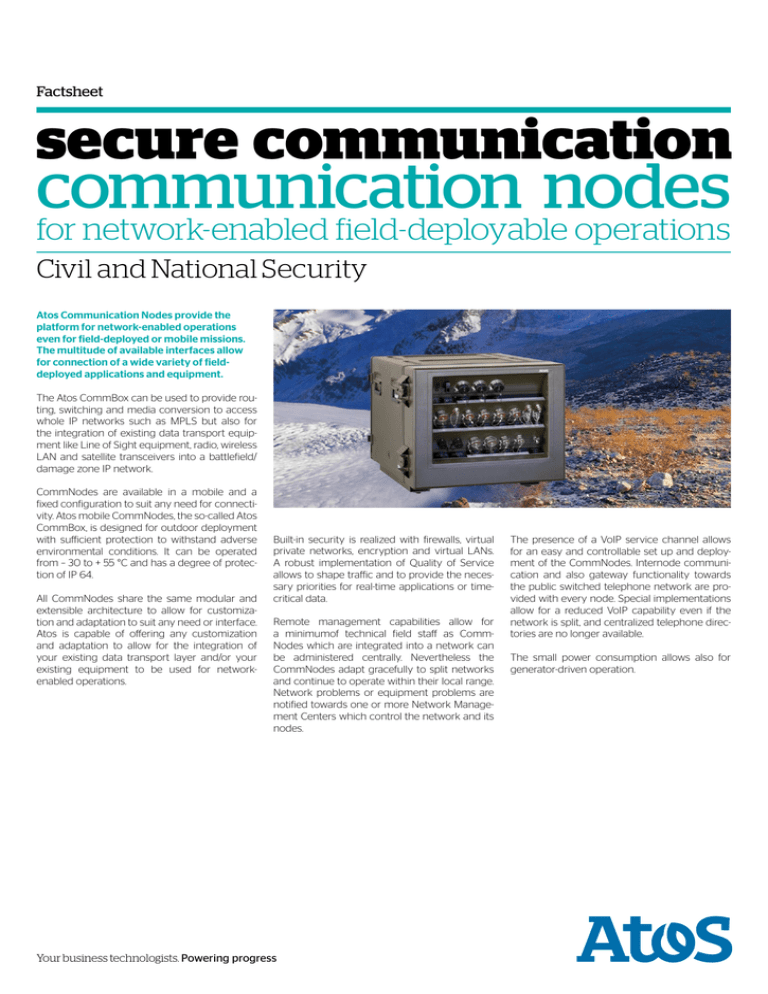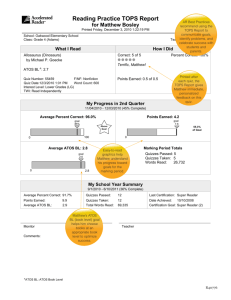
Factsheet
secure communication
communication
nodes
for network-enabled field-deployable operations
Civil and National Security
Atos Communication Nodes provide the
platform for network-enabled operations
even for field-deployed or mobile missions.
The multitude of available interfaces allow
for connection of a wide variety of fielddeployed applications and equipment.
The Atos CommBox can be used to provide routing, switching and media conversion to access
whole IP networks such as MPLS but also for
the integration of existing data transport equipment like Line of Sight equipment, radio, wireless
LAN and satellite transceivers into a battlefield/
damage zone IP network.
CommNodes are available in a mobile and a
fixed configuration to suit any need for connectivity. Atos mobile CommNodes, the so-called Atos
CommBox, is designed for outdoor deployment
with sufficient protection to withstand adverse
environmental conditions. It can be operated
from – 30 to + 55 °C and has a degree of protection of IP 64.
All CommNodes share the same modular and
extensible architecture to allow for customization and adaptation to suit any need or interface.
Atos is capable of offering any customization
and adaptation to allow for the integration of
your existing data transport layer and/or your
existing equipment to be used for networkenabled operations.
Built-in security is realized with firewalls, virtual
private networks, encryption and virtual LANs.
A robust implementation of Quality of Service
allows to shape traffic and to provide the necessary priorities for real-time applications or timecritical data.
Remote management capabilities allow for
a minimumof technical field staff as CommNodes which are integrated into a network can
be administered centrally. Nevertheless the
CommNodes adapt gracefully to split networks
and continue to operate within their local range.
Network problems or equipment problems are
notified towards one or more Network Management Centers which control the network and its
nodes.
Your business technologists. Powering progress
The presence of a VoIP service channel allows
for an easy and controllable set up and deployment of the CommNodes. Internode communication and also gateway functionality towards
the public switched telephone network are provided with every node. Special implementations
allow for a reduced VoIP capability even if the
network is split, and centralized telephone directories are no longer available.
The small power consumption allows also for
generator-driven operation.
On the CommBox all control elements and interfaces are located on one side of
the Box. Currently there are 19 connectors providing up to 38 different connections. The connector cover houses optical and electrical interfaces. The electrical interfaces are protected internally. An external signal distribution box
adapts the military type of connectors to civilian types.
A single switch allows for operation. This switch also allows to enter a maintenace state where the power consumption is minimized for a c
­ onfigurable duration. Three light-emitting diodes show the operational state of the CommBox.
System Deployment Example “Sensor Network“
The Atos CommNodes depicted in a configuration which enables a mobile sensor network
to be interconnected with mobile headquarters.
Mobile s­ensors (receivers, REC) are connected either directly with optical links between
­CommBoxes or via the deployment of Line of
Sight equipment to overcome larger distances.
Line of Sight equipment can be aggregated
on one CommBox. The Comm­Box can also be
used in a daisy chain manner to extend operational ­
distance using fiber optic lines. This
­configuration connects the mobile mission to a
fix network using a satellite link.
REC
CB
REC
REC
CB
CB
to HQ
CB
CB
CR
CB
REC
CB
CB
Mob HQ
Link Aggregation
Connections between different Comm­
Nodes
can be aggregated as shown with the example
of the aggregation of multiple Line of Sight links.
It is also possible to have several links between
sites to ensure higher availability by deploying
redundant links. The additional links can be of
different type than the main link. A connection
loss of the active link leads to an automatic
switch over to the next lower type, e.g. from a
fibre optic connection with a bandwidth of 100
Mbps to an aggregated Line of Sight link with
around 10 Mbps or even further to a link routed
via the PSTN with a merely 33 kbps. It is also possible to enable dial up functionality for maintenance purposes.
CR
CB
HQ Back
CB
CR
PSTN
HQ Front
Damage Zone
Redundant Networking and Network Management
Tact
Radio
CB
HQ
CR
CR
CB
Mob HQ
CB
PSTN
CB
CR
The Atos CommNodes can be deployed to
build a redundant network which allows for
high bandwidth and/or high availability of the
deployed missions. In this example the redundant connection between a mobile mission
and a fixed instal­lation is shown. The main data
stream is routed via a satellite link and a backup
connection is provided through the PSTN. It is
also possible to fully mesh the CommNodes for
further redundancy. The ability to extend the
network with Line of Sight equipment allows
to place the network elements and their associated functions (e.g. HQ or radio transceiver)
from a tactical and/or technical point of view.
The design of the Comm­
Nodes allows for
decentralized management to allow more than
one network management center (NMC) to be
connected to a system.
NMC
Combination of Fixed Operations with Mobile Operations
The rapid deployment of mobile equipment to
a certain area with the ability to access services
of a fixed network is being allowed and provided by the mobile Comm­Nodes/CommBoxes.
Their variety of interfaces allow to interconnect a mobile deployment with a wide range
of available networks including PSTN, MPLS or
others. The aggregation of connections allows
for higher bandwidth where single links do not
provide for the necessary data flows.
REC
REC
CR
CB
REC
CB
REC
CR
REC
CR
CB
HQ
CB
CB
CR
PSTN
CR
CR
WAN
CR
Mob HQ
Mob HQ
Mob HQ
Technical features
Networking Features
Interfaces CommBox
``10, 100, 1000 Mbps data rates on switch, router and firewall (Ethernet, FastEthernet, Gigabit
Ethernet)
``Electrical and optical interfaces for military type
of cables and fibres
``Compliant to ETSI, ITU-T, ANSI and EN standards
``Managed switch, switching capacity: 8.8 Gbps
``Modular, integrated services, high-performance
enterprise branch office router with a broad
range of interface options
``NAT/PAT for adaptation to legacy networks
``QoS capabilities
``Interfaces to PSTN for data and voice
``Integrated firewall, stateful inspection
``Virtual private network support
``Encryption: 3DES/AES
``Tamper-proof, sealable enclosure
``Virtual LAN ports, VLAN access lists
``16 × E1 with 2 Mbps (4 interfaces operational,
additional interface cards available on request)
``2 × E3 with 34 Mbps (interface cards available
on request)
``4 × 100 BaseT FastEthernet electrical (prepared
for PoE)
``3 × 100 BaseT FastEthernet optical (multimode,
field-capable fibres, single mode on interfaces
on request)
``1 × 100 BaseT (PoE enabled) for VoIP/maintenance
``1 × Power Out for Daisy Chaining of CommBox
or for external equipment
``2 × analog telephone connectors (33/56 kpbs
data via PPP)
``3 × digital telephone connectors (64 kbps data
via PPP, ISDN S/T and U interface)
``Both analog and ISDN links can be bundled to
achieve higher bandwidth links (e.g. 4 × 64 kbps
= 256 kbps)
``4 × serial interface (EIA 232, EIA 422, EIA 485)
``1 × antenna (interface card available on request)
QoS Features
Physical Specifications CommBox
Support of the entire QoS framework from Cisco
and includes the following techniques:
``Congestion Avoidance: Random Early Detection (RED), Weighted Random Early Detection
(WRED), Flow-Based Weighted Random Early
Detection
``Congestion Management using Class Based
Weighted Fair Queueing (CBWFQ), First in First
Out (FIFO) Queueing, Internet Protocol RealTime Protocol Priority (IP RTP Priority), Low
Latency Queueing (LLQ), Priority Queueing
(PQ), Weighted Fair Queueing (WFQ)
``Packet Marking: Distributed CAR (DCAR), Multi
Protocol Label Switching (MPLS)
``Tested to MIL-STD 810F (shock, vibration and
heat)
``Enclosure dimensions (L × W × H): 98 × 53 × 55 cm
(39” × 21” × 22”)
Security Features
Interfaces CommRack
``E1 with 2 Mbps
``E3 with 34 Mbps
``FastEthernet electrical
``FastEthernet optical
``VoIP/maintenance
``Analog telephone (data/voice) to PSTN
``Digital telephone connectors (S/T and U interface)
to PSTN
Remote Management Capabilities of
CommNodes
``Cisco Discovery Protocol (CDP)
``Remote Monitoring for router and switch
(RMON)
``SNMP trap generation
``MIB2 and private extensions
``Secured Web Access
VoIP Features
``Support of RTP, SRTP
``Control protocols: H.323, SIP, Skinny
``Codecs: G.711, G.723.1, G.726, G.728, G.729,
G.729.a, G.729.ab, G.729.b, GSM Full Rate
``Survivable Remote Site Telephony (SRST)
``PSTN Gateway
Power over Ethernet
``48 VDC for VoIP equipment
``All electrical Ethernet interfaces prepared for
PoE
Environmental Features
``Storage: – 40 to + 70 °C/– 40 to + 160 °F
``Operation: – 30 to + 55 °C/– 22 to + 130 °F
``Protection against dust, water and contact: IP64
Power Requirements
``Voltage input: 230 V or 110 V ± 10 %
``Minimal power consumption:
normal operation: 250 W
``Maximal power consumption:
with heating 650 W (if operated below
– 10 °C/+ 14 °F) or cooling 400 W (if
operated above + 23 °C/+ 70 °F)
Management System
``Centralized or dezentralized
``Redundant
``Node supervision and link supervision
For more information:
Please contact security.ch@atos.net
Atos AG, Civil and National Security, Freilagerstrasse 28, 8047 Zurich, Switzerland, Tel. +41 (0)58 702 1553
ch.atos.net/cns
Atos, the Atos logo, Atos Consulting & Technology Services, Atos Worldline, Atos Sphere, Atos Cloud, Atos Healthcare (in the UK) and
Atos Worldgrid are registered trademarks of Atos SA. June 2011 © 2012 Atos. All rights reserved.
Printed in
Switzerland
ZH 11/2012





